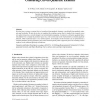Free Online Productivity Tools
i2Speak
i2Symbol
i2OCR
iTex2Img
iWeb2Print
iWeb2Shot
i2Type
iPdf2Split
iPdf2Merge
i2Bopomofo
i2Arabic
i2Style
i2Image
i2PDF
iLatex2Rtf
Sci2ools
VISSYM
2003
2003
Contouring Curved Quadratic Elements
We show how to extract a contour line (or isosurface) from quadratic elements—specifically from quadratic triangles and tetrahedra. We also devise how to transform the resulting contour line (or surface) into a quartic curve (or surface) based on a curved-triangle (curved-tetrahedron) mapping. A contour in a bivariate quadratic function defined over a triangle in parameter space is a conic section and can be represented by a rational-quadratic function, while in physical space it is a rational quartic. An isosurface in the trivariate case is represented as a rational-quadratic patch in parameter space and a rational-quartic patch in physical space. The resulting contour surfaces can be rendered efficiently in hardware. Categories and Subject Descriptors (according to ACM CCS): I.4.10 [Image Representation]: Volumetric I.3.5 [Computational Geometry and Object Modeling]: Curve, surface, solid, and object representations
| Added | 01 Nov 2010 |
| Updated | 01 Nov 2010 |
| Type | Conference |
| Year | 2003 |
| Where | VISSYM |
| Authors | David F. Wiley, Henry R. Childs, Benjamin F. Gregorski, Bernd Hamann, Kenneth I. Joy |
Comments (0)

